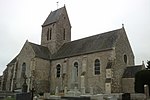Vire (river)

The Vire (French pronunciation: [viʁ] ) is a river in Normandy, France whose 128 km (80 mi) course crosses the départements of Calvados and Manche, flowing through the towns of Vire, Saint-Lô and Isigny-sur-Mer, finally flowing out into the English Channel. Its main tributaries are the Aure, the Elle and the Souleuvre. The outflow of the Vire has been canalized and forms the port of Isigny-sur-Mer. The poets of the Vire valley (Vau de Vire) are said to have given rise to vaudeville.Places along the river: Calvados (14) : Vire, Pont-Farcy, Isigny-sur-Mer Manche (50) : Tessy-sur-Vire, Troisgots, Torigni-sur-Vire, Condé-sur-Vire, Sainte-Suzanne-sur-Vire, Saint-Lô, Rampan, Pont-Hébert, La Meauffe, Cavigny
Excerpt from the Wikipedia article Vire (river) (License: CC BY-SA 3.0, Authors, Images).Vire (river)
Route du Wigwam, Bayeux
Geographical coordinates (GPS) Address Nearby Places Show on map
Geographical coordinates (GPS)
| Latitude | Longitude |
|---|---|
| N 49.356666666667 ° | E -1.1202777777778 ° |
Address
Pointe du Grouin
Route du Wigwam
14230 Bayeux
Normandy, France
Open on Google Maps











